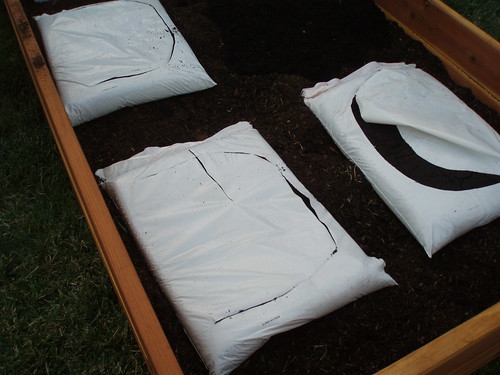 That's a whole ton of sh_t. Almost literally, really, the picture above is all the soil we bought for the vegetable garden, and it's mostly steer manure. If I can't grow something in this stuff, there is truly no hope for me. We used roughly equal parts garden soil and steer manure compost, and another half part peat moss. Square Foot Gardening recommends 1/3 compost, 1/3 peat moss and 1/3 vermiculite. Whatever vermiculite is, they didn't have it at OSH and I was in a hurry as usual. We even added in a little all-purpose organic fertilizer to the top layer.
That's a whole ton of sh_t. Almost literally, really, the picture above is all the soil we bought for the vegetable garden, and it's mostly steer manure. If I can't grow something in this stuff, there is truly no hope for me. We used roughly equal parts garden soil and steer manure compost, and another half part peat moss. Square Foot Gardening recommends 1/3 compost, 1/3 peat moss and 1/3 vermiculite. Whatever vermiculite is, they didn't have it at OSH and I was in a hurry as usual. We even added in a little all-purpose organic fertilizer to the top layer.Another plus to the raised bed, and a rather tall one at 12", is we don't have to worry about weeds or grass, especially crab grass, encroaching on the garden space. I did a flat bed with my mom's garden and we ended up digging a trench around and installing a wood border, this on top of all the digging we did to clear the bed in the first place. With this raised bed, we dug up about one whole square foot - just enough for the four posts to sit in the ground. We left the rest of the grass, it won't grow through 10" of soil, and will eventually break down to become nutrients for the veggies. The only drawback is I can't yet grow something with really deep roots like carrots, at least not yet.

We layered the ingredients in thirds and raked/mixed after each addition to make sure everything was well-incorporated. The end result is a porous, aerated, uber-nutrient-rich blank canvas ready to make yumminess. We got a late start, so we left planting the seedlings for another day, this gave the soil a chance to get some water and settle. For now we're watering it with the sprinkler right behind it in the corner there, but I won't want the tomatoes watered as often as the lawn once they really get going, so we'll have to figure something out.
Now before I break down the costs, I have to share one last tip, and beg you to forgive the little woman nature of it. Growing up without a man in the house, there is a certain handiness to Not Michael Landon that continues to amaze me, five years after moving in together. When mom and I used bags of steer manure compost, we'd open them up potato-chip-bag style, usually with whatever was lying around like a trowel or a rake or just tear at them with our hands until they finally gave in. Then we'd flip them over and attempt to distribute each bag evenly over the entirety of the 8'X8' bed, which mostly resulted in the momentum of the bag swinging us around until the majority was in a big clump in one corner, and the rest scattered a bit here and there.

So imagine my wonder when Not Michael Landon evenly sets out six bags of compost in our garden bed, makes a big open U-shape on each with a utility knife, and dumps each over in its place, resulting in a nearly even layer of compost with almost no effort at all. I was speechless. He wondered how I hadn't died off on my own already. You're probably too smart to be as amazed as I was, but here's a picture just for funsies.
With digging the holes, dumping everything in, turning and raking, this stage took all of about an hour. We bought a lot more soil components than we needed, but it will all get used eventually, in the next bed if not in other places around the yards.
Materials & Cost
This was all on a no sales tax sale, whoopee! Tools used were a spade, large shovel, and small rake.
Steer manure blend: 12 cu feet, 12 bags at $1.09 each = $13.08
Garden soil: 10 cu feet, 3 1/3 bags at $8.99 each = $29.97
Sphagnum peat moss: 2.5 cu feet compressed, 2/3 bag at $15.49 each = $10.33
All purpose organic fertilizer: 3.5 cups of 20lb bag at $19.99 = $1.17
With digging the holes, dumping everything in, turning and raking, this stage took all of about an hour. We bought a lot more soil components than we needed, but it will all get used eventually, in the next bed if not in other places around the yards.
Materials & Cost
This was all on a no sales tax sale, whoopee! Tools used were a spade, large shovel, and small rake.
Steer manure blend: 12 cu feet, 12 bags at $1.09 each = $13.08
Garden soil: 10 cu feet, 3 1/3 bags at $8.99 each = $29.97
Sphagnum peat moss: 2.5 cu feet compressed, 2/3 bag at $15.49 each = $10.33
All purpose organic fertilizer: 3.5 cups of 20lb bag at $19.99 = $1.17
Total: $54.55
The box and the soil are really the start up costs of this garden. Next year will involve some added compost, fertilizer, and seedlings, but this soil and box will be used again. So the sum total for the installation itself is $129.96 and 6 man hours of labor.
No comments:
Post a Comment